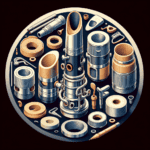Understanding the Clarinet Mouthpiece Tip Rail
Playing the clarinet involves more than just focusing on the reed, body, or ligature. The mouthpiece tip rail, a small but mighty component, can significantly impact your sound. Let's explore why this often-overlooked part deserves your attention!
The mouthpiece tip rail is a crucial part of your clarinet that influences the instrument's responsiveness, intonation, and tonal quality. It's where the reed meets the mouthpiece. A well-maintained tip rail ensures a solid connection with the reed, leading to better vibration and sound production. However, a neglected tip rail can cause various issues, from uneven tone to struggles with high notes. It's like having a friend who unintentionally complicates everything!
Selecting the Right Tip Rail
Wondering how to choose a tip rail that suits you? Here are some factors to consider:
- Material: Mouthpieces come with different tip materials like hard rubber, plastic, or wood. Each material affects your sound differently. Hard rubber warms the tone, while plastic tends to be brighter.
- Width and shape: These factors greatly influence playability. A narrow tip rail might make it harder to produce a full sound, while a wide one could affect articulation. Finding the right balance is key.
- Customization: Some mouthpieces offer customizable features. Remember, in music, it's all about finding what works for you!
| Tip Rail Material | Characteristics |
|---|---|
| Hard Rubber | Warmer tone, traditional choice |
| Plastic | Brighter sound, more affordable |
| Wood | Rich, complex tone, requires more maintenance |
Maintaining Your Tip Rail
Proper maintenance of your mouthpiece tip rail is essential for optimal performance. Clean it regularly to prevent reed residue buildup, which can negatively impact your playing experience. Use a quality mouthpiece brush to gently clean without causing damage. A little care goes a long way in ensuring excellent performance!
Impact on Intonation
The tip rail's alignment and condition significantly affect your clarinet's intonation. An incorrectly aligned or damaged tip rail can make staying in tune challenging. Regularly check your mouthpiece alignment – sometimes a slight adjustment can resolve seemingly major issues. It's similar to playing with a slightly out-of-tune guitar; frustrating, but often easily fixed!
Blow Resistance and Playability
A tip rail that's too thick or rough can increase blow resistance, making it harder to play your clarinet. Nobody wants to work harder than necessary while playing! The goal is to enjoy playing, not feel like you're running a marathon. Some brands, like Martin Freres, design their mouthpieces to balance blow resistance and ease of play effectively.
Conclusion
To sum up, your mouthpiece tip rail is a vital component that can significantly influence your overall clarinet performance. Choose wisely, maintain it regularly, and always be aware of how changes in your setup affect your tone and intonation.
On your clarinet journey, mastering these small details can make a big difference. Who would have thought the mouthpiece tip rail could be so important? Pay attention to your equipment, and remember: small adjustments can lead to substantial improvements!







